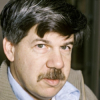Stephen Jay Gould

Stephen Jay Gould
Stephen Jay Gouldwas an American paleontologist, evolutionary biologist, and historian of science. He was also one of the most influential and widely read writers of popular science of his generation. Gould spent most of his career teaching at Harvard University and working at the American Museum of Natural History in New York. In 1996 Gould was also hired as the Vincent Astor Visiting Research Professor of Biology at New York University, where he divided his time teaching there and at...
NationalityAmerican
ProfessionScientist
Date of Birth10 September 1941
CountryUnited States of America
Stephen Jay Gould quotes about
We may need simple and heroic legends for that peculiar genre of literature known as the textbook. But historians must also labor to rescue human beings from their legends in science if only so that we may understand the process of scientific thought aright.
Darwinian evolution may be the most truthful and powerful idea ever generated by Western Science, but if we continue to illustrate our conviction with an indefensible, unsupported, entirely speculative, and basically rather silly story, then we are clothing a thing of beauty in rags - and we should be ashamed, "for the apparel oft proclaims the man.
If we make this readjustment to view Homo sapiens as an ultimate in oddball rarity, and life at bacterial grade as the common expression of a universal phenomenon, then we could finally ask the truly fundamental question raised by the prospect of Martian fossils. If life originates as a general property of the material universe under certain conditions (probably often realized), then how much can the basic structure and constitution of life vary from place to independent place?
We build our personalities laboriously and through many years, and we cannot order fundamental changes just because we might value their utility; no button reading "positive attitude" protrudes from our hearts, and no finger can coerce positivity into immediate action by a single and painless pressing.
I am particularly fond of [Emmanuel Mendes da Costa's] Natural History of Fossils because this treatise, more than any other work written in English, records a short episode expressing one of the grand false starts in the history of natural science and nothing can be quite so informative and instructive as a juicy mistake.
If you defend a behavior by arguing that people are programmed directly for it, then how do you continue to defend it if your speculation is wrong, for the behavior then becomes unnatural and worthy of condemnation. Better to stick resolutely to a philosophical position on human liberty: what free adults do with each other in their own private lives is their business alone. It need not be vindicated and must not be condemned by genetic speculation.
I have often been amused by our vulgar tendency to take complex issues, with solutions at neither extreme of a continuum of possibilities, and break them into dichotomies, assigning one group to one pole and the other to an opposite end, with no acknowledgment of subtleties and intermediate positions and nearly always with moral opprobrium attached to opponents.
A complete theory of evolution must acknowledge a balance between "external" forces of environment imposing selection for local adaptation and "internal" forces representing constraints of inheritance and development. Vavilov placed too much emphasis on internal constraints and downgraded the power of selection. But Western Darwinians have erred equally in practically ignoring (while acknowledging in theory) the limits placed on selection by structure and development what Vavilov and the older biologists would have called "laws of form.
Most books, after all, are ephemeral; their specifics, several years later, inspire about as much interest as daily battle reports from the Hundred Years' War.
Ordinary speciation remains fully adequate to explain the causes and phenomenology of punctuation.
The intricate and different life cycles of both male and female root-heads, and the great behavioral sophistication shown by the female in reconfiguring a host crab as a support system, all underscore the myopia of our conventional wisdom in regarding rhizocephalans as degenerate parasites because the adult anatomy of internal roots and external sac seem so simple.
Before Kuhn , most scientists followed the place-a-stone-in-the-bright-temple-of-knowledge tradition, and would have told you that they hoped, above all, to lay many of the bricks, perhaps even the keystone, of truth's temple. Now most scientists of vision hope to foment revolution. We are, therefore, awash in revolutions, most self-proclaimed.
An old paleontological in joke proclaims that mammalian evolution is a tale told by teeth mating to produce slightly altered descendant teeth.
Knowledge and wonder are the dyad of our worthy lives as intellectual beings. Voyager did wonders for our knowledge, but performed just as mightily in the service of wonder and the two elements are complementary, not independent or opposed. The thought fills me with awe a mechanical contraption that could fit in the back of a pickup truck, traveling through space for twelve years, dodging around four giant bodies and their associated moons, and finally sending exquisite photos across more than four light-hours of space from the farthest planet in our solar system.